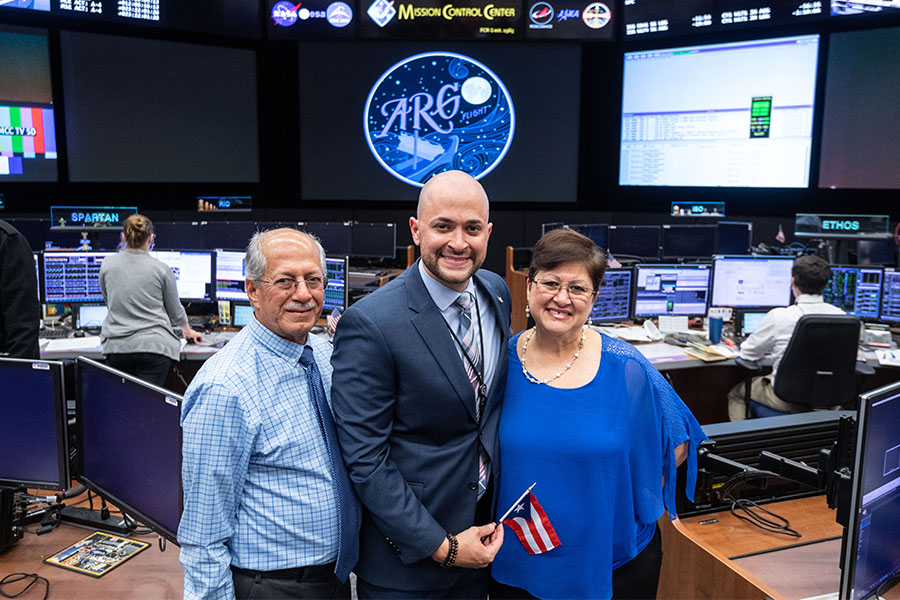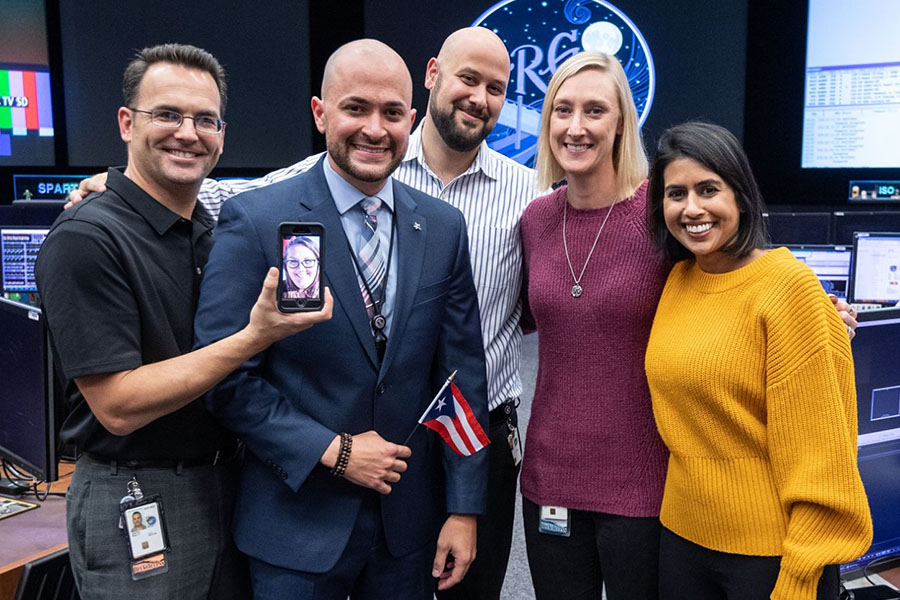"Argo Flight," alumnus Flores, certified as NASA flight director

Marcos Flores was grateful for the relative quiet.
After being certified as NASA’s 96th flight director Nov. 14, Flores’ first shift on console was the day before astronauts on the International Space Station were going to perform a spacewalk. So, for the most part, his shift while the astronauts were sleeping was uneventful.
Good thing, too.
For the first couple hours of the shift, Flores still was in deep reflection of all that’d just transpired.
His parents, Pablo Flores and Daisy Rodriguez, happened to be in Houston, after returning from vacation. That meant they weren’t in Puerto Rico, where they live, during another of Marcos’ big life moments. This time, they were there to experience it with him, beaming with pride that their son had “made it,” had accomplished his dream of becoming a flight director, after accomplishing the dream of becoming an employee at NASA, after accomplishing the dream of earning his master’s degree (in Aeronautics and Astronautics from Purdue in 2015).
Through the journey, Pablo and Daisy have been there, taking Marcos on his first trip to Kennedy Space Center as a 9-year-old kid, supplying him with space toys and making sure any shuttle launch was displayed on the TV. And now, here he was, giving a thoughtfully prepared speech, one in which he told them in Spanish, essentially, “This is for you.”

A speech that also revealed what everyone in the room was waiting to hear: The call sign he’d forevermore be identified by, “Argo Flight.”
All of it seemed too perfect — the way he shared how Argo, the ship from Greek mythology, lined up with his personal journey; how his parents were there to offer hugs; how other colleagues within NASA were happy to pack the room to offer congratulations; how the patch designed by good friend Rachel Nieman was unveiled; how the bulk of his flight director class, including another Boilermaker, Allison Bolinger, were there to celebrate.
“My emotions were all over the place,” Marcos Flores said during a phone interview Dec. 4, having logged another nine shifts by that point. “This is something I’ve worked hard for, for the last year and a half, a lot of training, a lot of headaches and a lot of stress just to try to get through it. But, at the same time, it’s one of those very inspiring moments because it’s a major achievement in your career as well. You don’t even realize what you’re doing until you actually take over and see yourself, at least from the outside, and understand what you just did. So it was lot of emotions in terms of happiness and, at the same time, anxiety in a way because you’re about to take on this responsibility by yourself. There’s nobody else going to be there watching you or be there as a safety net. So the responsibility that falls on your shoulders kind of stresses you out at the same time.”
Naturally, then, he needed a minute.
So he took it, early in that first shift, after all the well-wishers had left, solely in charge for the night.
“It was one of those shifts like, all right, it’s quiet enough, you can let everything sink in and settle out and do the job and not have to worry about other things going on at the same time. It was exactly what I needed,” he said. “It helped me appreciate whatever happened a lot better, because I actually had time to settle into it and think about it more. It was great.”
A quiet moment seems a gift now.
Even before he was certified, Flores got his first assignment as lead flight director on the next Japanese H-II Transfer Vehicle (HTV) mission. Flores is charged with leading the mission from the International Space Station perspective and overall integration. As part of the preparation, he spent a week in Japan in early December.
In parallel to that work, Flores also is in charge of the next major flight software upgrade for the ISS computers, and he’s working with a group toward upgrading the software on board with new features and fixing problems. That could roll out within the next couple months.
He also recently was given the assignment as the lead flight director for NASA’s next-generation space suit that will be used in Exploration Missions to the Moon. It’s only in the early stages, but he will participate in all design reviews and concept development to make sure the new suit provides the proper capabilities and necessary features for the missions. There’s a demonstration mission that will fly to ISS in the next two or three years for that, Flores said, and then the suit will undergo iterations before astronauts are sent to the Moon in the suits.

In addition to those three major assignments, there also are other certifications Flores will need to obtain, ranging from gaining knowledge of visiting vehicle operations (for Russian vehicles, for example) to participating in simulations and training requirements to lead future space walks.
Quite a significant load already — but no complaints from Flores.
“You hit the ground running. It doesn’t matter how many shifts you’ve done or how much time you’ve been in the (Flight Director) Office, you’re expected to be a flight director 100 percent from Day 1,” he said. “I’m appreciating the impact I have. It’s a big learning curve because you’re thrown to the wolves, if you will. But at the same time, I appreciate it and it’s very rewarding just to see how much of an impact you can have on everything that’s done to make sure it’s done the right way.”
Flores always had a mental picture of what a flight director was — a well-respected leader with the conviction to make crucial, firm decisions, based on personal knowledge and input from talented teammates.
His year-long training and simulations helped prepare him, as did his previous NASA experience, but he admits it has felt different being “official” and certified than when he was first selected to the class in July 2018.
He said he appreciates the job more now, truly grasping the level of responsibility that comes with it. What he says is going to impact plans and execution of those plans of future missions. His influence is considerable — in a pivotal time for the world’s greatest space agency, with missions planned to return to the Moon and beyond.
It’s exactly where Flores wants to be.
“It hasn’t necessarily sunk in completely. I’m not sure it’s even going to be possible for that to completely sink in ever, just because of how dynamic the operation is here and how many things are going on, all the challenges we have coming up and things we have never done before or things we haven’t done in a long time. How we figure all that out is going to be challenging,” Flores said.

He’ll always be reminded of his place in it all — his patch is visible every shift, glowing on a monitor in the front of mission control. It’s a beautiful design, stars littering the sky with the Moon prominent – it’s the “o” in Argo — and a grayish blue ship on the seas interwoven among the black background.
It symbolizes Argo, the ship in Greek mythology designed to explore the seas to retrieve the Golden Fleece, a symbol of kinship and authority. The more Flores read of the story of Jason and the Argonauts – the group of daring individuals who accepted the challenging mission of daily overcoming obstacles with discipline, competence, confidence, toughness and vigilance — the more he realized it aligned with his personal journey and NASA’s mission.
“I just wanted something that matched not just my background but also matched the intent of what being a flight director is. I think Argo fit all of that,” he said. “I think the name resonated with me not just because what we do at NASA but my entire voyage coming from Puerto Rico, growing up there and all the challenges I had to face to come over to the States and get a job at NASA, and all the things I had to go through to get to the point leading up to becoming a flight director. So I found the analogy very interesting in terms of what the story was and how I ended up here.
“Every time I go look at (the patch) and I’m like, ‘That’s me,’ I can’t believe it sometimes. I still freak out a little bit. I’m like, ‘Wow. I just can’t believe I’m sitting on this chair right now and all these people are looking up to me.’ But at the same time, that comes with another wave of, ‘Oh man, I’m actually responsible for all these people. I need to make sure I’m doing the right thing, and that I’m leading them correctly so we do the right thing at all times.’ It’s a combination of emotions that I’m not sure ever goes away.”
